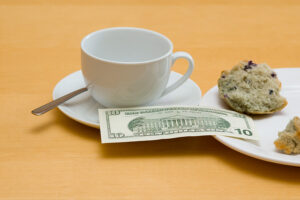In many restaurants when your server presents you with the bill, it lists the various amounts of a tip in percentage form — but what should you really pay?
By Bruce Frassinelli

As pleasurable an experience as dining out is, the least pleasant part of the meal is when the check arrives, and we are faced with what to do about the tip.
Examine your own tipping habits: Do you give a set percentage, regardless of extenuating factors such as the speed and attentiveness of the server, or do you run a scorecard starting at let’s say 20% of the total bill, then taking off points for this or that? Or do you do something completely different?
Do you vary your tipping method based on the type of establishment where you are dining? Do you tip when you are taking out food or only when you eat on the premises? Do you tend to tip more if you are with someone so you are not thought to be a cheapskate?
If you have a $100 meal with your spouse or significant other, do you tip on the total bill of $107, including sales tax, or do you take the percentage on just the pre-tax amount?
There are so many things to consider, which is why some diners just say, “Oh, the hell with it, let me just add 20%, 18%, 15%, or whatever.”
Of course, today, in many restaurants when your server presents you with the bill, it lists the various amounts of a tip in percentage form, so you can choose one of these, or there is a spot for you to add another amount.
I find the whole tipping concept maddening. I just wish that restaurant owners would pay their employees a livable wage just like any other business, rather than rely on us customers to supplement the servers’ and other restaurant employees’ compensation.
If as a matter of principle I choose not to participate in the tipping game, I am considered a low-life by servers. Yes, a tip is optional, but it is a known fact that some servers are wary and try to avoid persons from countries where tipping is either nonexistent or much less generous than here in the United States.
I will never see a change of this system in my lifetime, maybe not even in yours, but as restaurant prices continue to rise because of inflation, the amount of the tip also becomes automatically inflated if you base your tip on a percentage of the total bill. I know for a fact that many patrons will forego a mixed drink or cocktail, because it automatically could inflate the bill by as much as $20, not including the additional tip.
Tipping is practiced around the world, but it plays a unique role in the United States because of our allowing businesses to offload to their customers the burden of paying what amounts to supplemental compensation. Tipping has come to be considered as a fair way to encourage hospitality and to reward good service, whereas tipping’s roots are in racialized exploitation.
It is said that “TIPS’’ is an acronym meaning “To Insure Prompt Service.’’ One etiquette book says that “TIPS’’ is a “valuable reminder to reward those who provide excellent service to you with a proper gratuity for their efforts.’’
Eating out, even at fast food places such as McDonald’s, Burger King and pizza joints, is becoming increasingly beyond the reach of some diners, so where is the breaking point for them when they must throw in the towel and pass up one of life’s simple but enjoyable pleasures?
Some of these fast-food establishments have a built-in advantage because of their no-tipping policy. If you are feeding a family of four at McDonald’s, for example, and you spend about $50, you are going to save up to about $10 because you don’t have to add a tip. Many fast-food restaurants have increased their hourly rates for employees to between $12 and $15, depending on location and competition for help.
After all is said and done, we come back to the same old argument: Is tipping fair, why do we fret about it so much, and what, if anything, can we do about it?
The COVID-19 pandemic muddied the tipping waters considerably, because prospective diners who were closeted at home almost exclusively for the first 24 months of the pandemic did mostly takeout, and many had compassion for restaurant workers who were toughing it out during this bleak period and tipped generously.
Now, according to recent surveys, diners are not nearly as generous as they were even as recently as in mid-2022. Many of them are forgoing a percentage tip, especially as the price of meals escalates dramatically.
Tipping has long been controversial, even being regarded as “un-American’’ in our post-Civil War era. Three states — Tennessee, South Carolina and Iowa — outlawed tipping, but these laws were repealed in 1926.
Restaurateurs embraced tipping as a way to avoid paying higher wages to staff. In 1938, after intense lobbying efforts, the tipping structure that is largely the one in effect today became part of the Fair Labor Standards Act, which ensures a federal minimum wage but excludes restaurant and hotel workers.
Some states have ridiculously low minimum wages for these workers, with the expectation that diners and guests will make up the rest of a decent salary through tipping. I find the system to be classist, even sexist and racist when these jobs in some categories are filled largely by immigrant women or persons of color. Housekeepers at hotels come to mind.
Some companies from time to time have attempted to do away with tipping. One of the recent efforts was made by Shake Shack founder and entrepreneur Danny Meyer, who made headlines several years ago when he announced a no-tipping policy at his restaurants. A few independent restaurants followed suit, but by 2018, the no-tipping movement lost momentum and many restaurants returned to tipping.
The reason? To accomplish this switch, the restaurants had to increase their prices to allow for a sustainable profit, causing diners to rebel. When this happened, waitstaff and support staff employees quit in droves.
Now that the aftermath of the pandemic is being taken largely in stride, getting enough employees to staff restaurants and hotels remains an enormous challenge, to the point where the quality of service is suffering mightily.
A bagel shop I frequent posted this sign: Please be patient, we are doing the best we can with the personnel available. If you can’t be patient and think you can do it better, please ask for an application.’’
Shake Shack’s Meyer publicly reneged on his controversial experiment. Bottom line: Despite tipping’s horrible history, the model is apparently here to stay, at least for now.
Some dramatic changes have occurred. As I indicated earlier, many of the national fast-food chains have implemented a $15 minimum wage, which ups the ante considerably. It also has raised prices at these places, meaning low-earning families cannot go out to eat as often, if at all.
As a result of this, many states have either changed their minimum wage rate to benefit this classification of employee or are considering doing so. New York has changed its rate to allow for a $15-an-hour total tipped maximum wage comprised of a $10 minimum wage rate and a $5 maximum tip credit. This rate is the second highest in the nation next to California’s and compares favorably to adjacent states where the rate is lower.
Ultimately, an equitable tipping system will require jettisoning the subminimum tipped wage and paying servers, bartenders and other service employees the standard minimum wage, while allowing them to receive bonuses for exceptional service. To achieve this desired goal will require that everyone — owners, servers and diners — get on board with the program. I suspect that having a camel squeeze through the eye of a needle will be an easier task.




